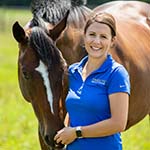Our fantastic team of equine specialists do a lot of diet evaluations remotely, which is a slight disadvantage compared to a hands-on evaluation. It is much preferred to see a horse in person, but a lot of times this simply isn’t feasible. It is for this reason that when we do a remote diet evaluation, we always ask for recent photos.
Our team is trained to ask for photos, not because we don’t believe the owner when they say they would like for their horse to gain weight. Rather, we ask for photos because some horses who are thin need to gain body condition, but some horses have good fat cover over their ribs and look thin because of poor muscling. In order to make the best diet recommendation, it is very useful to see exactly what condition the horse is currently in.
The traditional way to evaluate a horse is the Henneke Body Condition Scoring System. It is a numerical scale used to evaluate the amount of fat on the horse’s body. The scale ranges from 1 to 9, with a BCS of 1 being extremely emaciated and a BCS of 9 being extremely fat. A BCS of 4 to 6 is considered in the healthy range. The fat over the ribs is the best place to evaluate fat cover. At a BCS of 5, the ribs will not be visible but are easily felt with light pressure.
The breed and discipline of choice often dictates where in the range of healthy scores is considered ideal. For example, a horse showing in the halter classes would have a different ideal than a roping horse, which may have a different ideal than a racehorse, even though all three are Quarter Horses.
The problem with the Henneke system is that it only considers fat cover and oftentimes, that does not tell the whole story.
For that reason, we utilize the Tribute® Equine Nutrition Wellness System to separately evaluate Body Condition Score as well as topline muscling. The Wellness System also scores the presence and size of fatty deposits along the crest, which can be an indicator of metabolic issues.
Body Condition Scoring is important because it allows us to evaluate the horse’s energy intake. A horse that has a low BCS (<4) needs to consume more energy; often times, this is accomplished by feeding more concentrate, feeding a concentrate that is more calorie dense or adding a fat supplement. A horse that is overweight (>6) needs a reduction in calories, although we have to be careful that we don’t also cut essential nutrients from the diet. For this reason, we will use a ration balancer to limit energy intake without undersupplying essential nutrients.
Horses that have good rib cover but still look thin are often under muscled. Simply feeding more calories won’t fix this particular issue. Even feeding more protein is often not the answer to building muscle. Instead, we need to focus on supplying specific amino acids that are lacking in forages. These are typically lysine, methionine and threonine. By supplying these limiting amino acids, it allows the horse to use the rest of the protein in the diet more efficiently to build muscle.
Limiting amino acid supply in the current concentrate should be evaluated, as well as the amount of concentrate being fed. If you are feeding below the minimum recommended rate, you will be undersupplying amino acids. Some horses who are on a quality feed and fed at the appropriate rate can still benefit from additional amino acid fortification to reach their genetic potential for muscle development. Ration balancers are a very economical way to boost amino acid content and can be added to your existing feeding program without upsetting the overall balance of nutrients.
Unsure if your horse needs to gain body condition or muscle? Contact us for an evaluation today!

